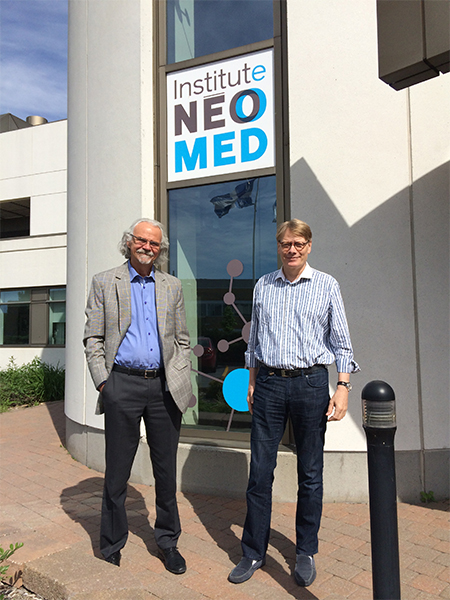
Closure of major R&D labs by Merck & Co., Boehringer-Ingelheim, AstraZeneca, Johnson & Johnson and Sanofi-Aventis over the past few years left Québec’s pharmaceutical research talent teetering on the edge of the patent cliff.
Greater Montréal was hit the hardest. But it’s hitting back.
Québec still barely tops Ontario in its share of national R&D activity, with 43 percent. And pharmaceutical manufacturing employed 27,000 people in the province in 2013.
But Statistics Canada notes that total business R&D expenditures by Canadian pharma have fallen below $1 billion since 2011, and fell by 15.6 percent between 2001 and 2012. However, the agency notes that the industry’s changing business model means more R&D conducted via investments in small-to-medium enterprises (SMEs), venture funds and work with Canada’s growing family of contract service providers. A survey by Rx&D and KPMG reported that R&D expenditures of this type totaled $221 million in 2012.
Enter NEOMED and the NEOMED Institute, a pole of drug discovery literally risen from the ashes of a global research center in Laval closed by AstraZeneca two years ago at Technoparc Montréal. As of this summer, just 18 months after its founding, NEOMED’s roster of 22 small, nimble and effective companies employed more people (145) than were let go at the time of AstraZeneca’s facility’s closure (132).
“We are proud to have exceeded this symbolic threshold because it shows that it is possible to not only maintain but also create highly skilled jobs in pharmaceutical discovery and development in Montréal,” said Max Fehlmann, president and CEO of the NEOMED Institute, on May 29. “In fact, these are not solely jobs that existed elsewhere previously then regrouped in the Institute. We have also been an important catalyst in the creation of 57 new jobs, three new companies, and have attracted three foreign enterprises to create Canadian divisions — all within less than two years.”
“We are thrilled to see the leadership role of the Institute within the community, an initiative that demonstrates the ability of the sector to undertake and develop new models, new platforms, new competitive businesses, and allows us to attract investments,” said Michelle Savoie, president and CEO of Montréal InVivo, a cluster representing 620 life sciences and health technology organizations in Greater Montréal, including more than 150 research centers, 80 company subsidiaries and 41,000 people employed in the sector.
Shared Assets, Shared Vision
Key to the work at NEOMED are advanced services, including analytical services and access to a vivarium. Also key is the vision of leaders like Fehlmann and Philippe Walker, chief scientific officer, who until June 2012 was vice president and head of the AstraZeneca R&D Montréal research center. A former member of AstraZeneca’s Global iMed leadership team for NeuroScience, he was recruited 20 years ago by Astra to help select a North American location for the company’s analgesia drug discovery activities, and was instrumental in establishing the Astra Research Centre in Montréal.
“We chose Montréal because of its strengths of science in pain research,” Walker told Site Selection during a visit to NEOMED just before the May announcement. McGill University was a leader in that field, and helped Montréal win the investment after a worldwide study. After the merger in 2000 with Zeneca, a number of site closures followed.
“I was involved in the management of neuroscience for the company, and not completely surprised when I was told I had to close the Montréal site in early 2012,” said Walker. “There is a big change in pharma’s R&D business model. Many companies are reducing their geographic footprint … which is a kind of euphemism.”
Walker and Fehlmann had collaborated before, and decided to do so again. “We thought it was a fantastic opportunity,” said Walker, given that pharma was doing less internally, was wanting to acquire from the outside, but most academic centers were not set up to accommodate those new pathways.
“We went to the [Québec] finance minister and said we wanted to build a bridge between the academic and pharma,” said Walker. “We negotiated the transfer of the equipment and building and some of the assets to start the NEOMED Institute.”
“I led the negotiations with Astrazeneca,” said Fehlmann. “It was tough to get everything … but we got it. Then we tried really to see the entire community in Québec, convincing them it could be a project for the entire province.”
They met with doubts about their ability to manage the enterprise, beginning with the cost of operating the building. So the team took on the daunting prospect of renting out space to small companies in a building not constructed for that purpose, with more than 50 percent of the space unrentable due to infrastructure and other special-purpose space.
“We rented this much faster than we thought,” says Fehlmann.
“We use the building as our giant toolbox,” says Walker, with the goal of finding exciting new projects looking to outlicense or in early phase-two research. “That is when projects are de-risked,” he says. “We’ve built a portfolio of projects stemming from the very good research that happens in Canada and around the globe.”
Walker says 40 percent of the proposals come from the US, 30 percent from Canada and the balance from Europe and Asia. Companies are able to make, analyze and test compounds, and the synergy among them helps advance things “much faster than if we were completely virtual,” he says.
Independent, But Not Alone
“We are not an incubator,” explains Fehlmann. “We don’t help the companies — they are completely independent. We do business with them, they do business with each other. We have no responsibility for them, but we get all the value from the services we provide.”
A number of former big pharma employees get real value too — as in jobs. Paraza and IntelliSynRD are just two of the NEOMED companies that have hired numerous staff from the industry bloodletting two years ago. Twenty people now working at the institute used to work for AstraZeneca.

Now there’s a waiting list of companies. So NEOMED is building a new administrative building adjacent to the current building in order to make space available for more biotech firms in clinical development.
Walker notes that one of the institute’s big attractions is the quality of its infrastructure.
“AstraZeneca put a lot of care into building labs just for chemical design,” he says, with chemical hoods and high-caliber ventilation. “We inherited all the strategic equipment, and a very powerful purification machine, the only one in Canada. So small companies can access it on a rental basis.”
Sometimes the small companies have scars similar to NEOMED’s: Cyclenium Pharma Inc., a newly formed pharmaceutical company specializing in the research and development of novel drug candidates based on proprietary macrocyclic chemistry, announced in March its move into NEOMED. Cyclenium was founded by management and scientists from Tranzyme Pharma, which recently closed its Québec R&D site in Sherbrooke.
“We are very pleased with this opportunity to jump-start our R&D efforts at the NEOMED Institute,” said Dr. Helmut Thomas, president and CEO of Cyclenium Pharma. “The location is ideal in providing a host of services that would otherwise be beyond the reach of a start- up enterprise. This will permit us to concentrate our attention on rapidly building our capabilities and developing our breakthrough next generation macrocyclic library.”
In December NEOMED announced a new collaboration with Johnson & Johnson Innovation, and its affiliate Janssen Inc. Canada, to accelerate the transition of university and biotechnology company early-stage research into potential treatments. Engene, which specializes in delivering genes in proteins into the GI tract, recently moved to the site from its home base in Vancouver. And in April the institute announced the launch of a new oncology drug discovery project from Florida-based company Epigenetix Inc., which NEOMED selected to develop novel inhibitors of Brd4, a protein that functions as an epigenetic modulator and whose potential in the treatment of cancer is being explored. The initial stages of drug discovery will involve IntelliSynRD, the Montréal-based medicinal chemistry company already located at NEOMED.
Also among the arrows in NEOMED’s quiver is its sheer industrial competence.
“Our team is tested veterans, who have brought drugs to Phase II,” says Walker. “It’s an interesting dialogue to have with academic labs, because they are usually quite naive in terms of what needs to be done in drug discovery. We are very selective in what we take on board, and we do not take programs too long if there’s no hope. It’s easy to recognize a wall when your nose touches it, but we try to predict the fate of programs.”
Both men agree the attraction of the university community’s research expertise is still there today as it was when Astra came 20 years ago. They’re in discussions with a number of global companies from around the world interested in pain control research. The institute’s longevity figures to be helped if a big customer comes along, as NEOMED’s ambition is to be independent of government funds after five years. Fehlmann says they’re also in discussions with venture capitalists.
“We couldn’t hope to do that if we were to rely only on programs that would barely emerge from academia,” says Walker. “So we obtained three assets from AstraZeneca — some were already in clinic, some were close. That’s what we’re going to use to hopefully generate some cash for the public-private fund.”
Walker says now that the target-to-launch integrated R&D of the old big pharma model has gone by the wayside, gaps between academia and industry are appearing not only culturally, but in financing, as the big federal agencies in the US and Canada don’t necessarily finance the making of early compounds for emerging targets. “So there’s this huge gap,” he says. “Our ambition is to propose a new model, a federated approach to finance this high-risk early research. Share the risk but also the rewards of crossing that death valley.”
Worth the Trip
Anthony Cheung, CEO of Engene, crossed the country. He says it’s a different vibe in Montréal, but a necessary difference for progress.
“The great thing about Vancouver is every professor in the university there has a startup company in the drawer,” he says, “so in the early stages, it’s very vibrant. But once you pass that stage, then you feel the strain — they don’t have a lot of expertise, and Vancouver has never been a pharma hub. Montréal has decades of pharma, and we’re finding people with a lot of development experience. It’s a huge difference.”
The same goes for access to manufacturing experience, and to contract research organizations, he says. He also gives full credit to the Québec government.
“Québec’s is the first provincial government to see that there ‘s a need to keep biotech here,” he says. “Most pharma repatriated foreign research back home. All of a sudden, 3,000 people got a pink slip. These are high-paying, good jobs. The government stepped up quickly to put the money into investors, and use them to help build the industry from the ground up.”
Engene was one beneficiary, benefiting from site selection and incentive assistance from Invest Québec. He notes that while the federal tax break on R&D refunds half of every dollar spent on R&D, “In Québec it’s sweeter — every dollar you spend on FTEs in head count, you get about 70 cents back. Our business is a human-resources-heavy type of industry, so that’s motivated us to hire more people.
“Vancouver is fun in early-stage stuff,” Cheung says, “but once you churn, Montréal is probably the best place in Canada.”

